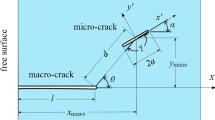Abstract
The evaluation of crack initiation, short-crack growth as well as crack path at microscopic scale is a crucial issue for the safety assessment of macroscopically fracture-free structural components. In the present paper, the crack propagation at the material microscale is modeled by taking into account the spatial variability of mechanical characteristics of the material as well as the local multiaxial stress field disturbance induced by inhomogeneities (inclusions or voids). By adopting some crack extension criteria under mixed mode, the short-crack path is determined. A microstructure dependence of the crack path arises in the short-crack regime, while the microstructure of the material does not influence the crack propagation for sufficiently long cracks. A mean weighted equivalent stress-intensity factor (SIF) is computed for kinked short cracks, where the range of such a SIF can be used as a key parameter dictating their fatigue crack growth rate.
Similar content being viewed by others
References
Suresh S.: Fatigue of Materials. Cambridge University Press, Cambridge (1998)
Suresh S.: Crack deflection: implications for the growth of long and short fatigue cracks. Metall. Trans. 14, 2375–2385 (1985)
Kitagawa H., Yuuki R., Ohira T.: Crack-morphological aspects in fracture mechanics. Eng. Fract. Mech. 7, 515–529 (1975)
Carpinteri, A., Spagnoli, A., Vantadori, S.: Correlating the fractal dimension of a continuously-kinked fatigue crack with some material microstructural features. In: Proceedings of The 13th International Congress on Mesomechanics, Vicenza, Italy (2011)
Brighenti R., Carpinteri A., Spagnoli A., Scorza D.: Crack path dependence on inhomogeneities of material microstructure. Frattura ed Integrità à Strutturale 20, 6–16 (2012)
Honein E., Honein T., Herrmann G.: Aspects of heterogenization. J. Eng. Mater. Technol. Trans. ASME 116, 298–304 (1994)
Honein T., Herrmann G.: On bonded inclusions with circular or straight boundaries in plane elastostatics. J. Appl. Mech. Trans. ASME 57, 850–856 (1990)
Erdogan F., Sih G.C.: On the crack extension in plates under plane loading and transverse shear. J. Basic Eng. 85, 519–527 (1963)
Sih G.C.: Strain-energy-density factor applied to mixed mode crack problems. Int. J. Fract. 10, 305–321 (1974)
Maiti S.K., Smith R.A.: Comparison of the criteria for mixed mode brittle fracture based on the preinstability stress-strain field, part I: slit and elliptical cracks under uniaxial tensile loading. Int. J. Fract. 23, 281–295 (1983)
Shafique M.A.K., Marwan K.K.: Analysis of mixed mode crack initiation angles under various loading conditions. Eng. Fract. Mech. 67, 397–419 (2000)
Carpinteri A., Spagnoli A., Vantadori S., Viappiani D.: Influence of the crack morphology on the fatigue crack growth rate: a continuously-kinked crack model based on fractals. Eng. Fract. Mech. 75, 579–589 (2008)
Bilby B.A., Cardew G.E., Howard I.C.: Stress intensity factors at the tips of kinked and forked cracks. In: Taplin, D.M.R. (ed.) Fracture 3, pp. 197–200. Pergamon Press, New York (1977)
Lo K.K.: Analysis of branched cracks. J. Appl. Mech. 45, 797–802 (1978)
Cotterell B., Rice J.R.: Slightly curved or kinked cracks. Int. J. Fract. 16, 155–169 (1980)
Chen Y.Z.: Stress intensity factors for curved and kinked cracks in plane extension. Theor. Appl. Fract. Mech. 31, 223–232 (1999)
Carpinteri A., Brighenti R., Vantadori S., Viappiani D.: Static crack extension prediction in aluminium alloy at low temperature. Eng. Fract. Mech. 75, 510–525 (2007)
Ayatollahi M.R., Pavier M.J., Smith D.J.: Determination of T-stress from finite element analysis for mode I and mixed mode I/II loading. Int. J. Fract. 91, 283–298 (1998)
Berto F., Lazzarin P.: On higher order terms in the crack tip stress field. Int. J. Fract. 161, 221–226 (2010)
Berto F., Lazzarin P.: Multiparametric full-field representations of the in-plane stress fields ahead of cracked components under mixed mode loading. J. Fatigue 46, 16–26 (2013)
Murakami Y.: Metal Fatigue: Effects of Small Defects and Nonmetallilc Inclusions. Elsevier, Amsterdam (2002)
Li V.C., Mishra D.K., Wu H.C.: Matrix design for pseudo-strain-hardening fibre reinforced cementitious composites. Mater. Struct. 28, 586–595 (1995)
Spagnoli A.: A micromechanical lattice model to describe the fracture behaviour of engineered cementitious composites. Comput. Math. Sci. 46, 7–14 (2009)
Author information
Authors and Affiliations
Corresponding author
Rights and permissions
About this article
Cite this article
Brighenti, R., Carpinteri, A. & Spagnoli, A. Influence of material microvoids and heterogeneities on fatigue crack propagation. Acta Mech 225, 3123–3135 (2014). https://doi.org/10.1007/s00707-014-1111-7
Received:
Revised:
Published:
Issue Date:
DOI: https://doi.org/10.1007/s00707-014-1111-7




